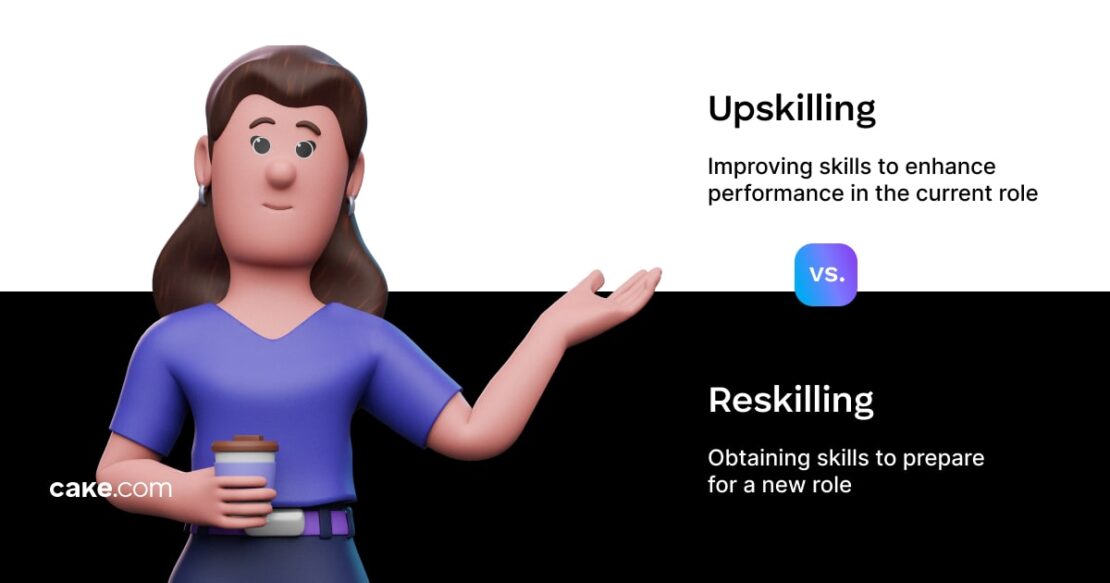With the latest technologies bringing major changes to the workplace, the ability to adapt and evolve is becoming increasingly important.
To successfully tackle industry changes and remain competitive in the market, employers and employees turn to reskilling.
So, what is reskilling, and how can it help businesses and workers? What is the best way to approach it and what are the common mistakes companies make when crafting a reskilling strategy?
To answer every burning question, we’ve contacted key experts in the field and asked for their most helpful reskilling insights. We’ll cover crucial reskilling aspects and go over a reskilling playbook to help you mitigate mistakes in this process!
What is reskilling and how does it benefit your growth?
Reskilling is a process during which an employee gains new skills, usually for the purpose of advancing at their job.
For Tara Furiani, Executive Coach, People Consultant, and Not the HR Lady podcast host, reskilling is about “preparing employees for a role shift by equipping them with new, critical skills.”
Founder of Transition & Thrive with María, María Tomás-Keegan, believes that investing in broadening their skill set brings employees:
- Career security,
- Increased marketability,
- A clearer sense of purpose,
- Higher job satisfaction, and
- Personal growth.
Furthermore, Furiani notes that employees who invest in themselves are “setting themselves up for accelerated growth and leadership opportunities.” She believes investing in broadening our skills can expedite our career progression:

“The future belongs to those who can adapt quickly, leverage new technologies, and think beyond their current role. These employees will have more influence over their career trajectory and increased opportunities in emerging industries.”
In addition, employers who invest in increasing their workers’ abilities are creating a “more flexible, innovative, and committed workforce”, as Tomás-Keegan notes.
Founder of JupiterHR, Jermaine L. Murray, explains that, when changes in the industry occur, it’s “cheaper to reskill than it is to hire someone completely new off the market.”
“History shows us the introduction of new technology also sees the introduction of new jobs”, he continues. Thus, instead of hoping that tools will replace existing employees and having to hire more qualified people when this turns out to be false, the most cost-effective option is to prepare existing workers for upcoming industry changes.
Lastly, Furiani clarifies that an investment in employees’ skills is an investment in innovation and future readiness. She adds: “It’s about cultivating a workforce that can pivot as technology advances, tackle new challenges, and drive organizational growth.”
Is AI accelerating the need for reskilling?
According to OECD’s predictions, automation could replace 14% of jobs within the next 15 to 20 years. What’s more, 32% of jobs would likely face radical changes with automation.
Experts believe that reskilling can mitigate this issue and allow employees to take advantage of technological advancements via skill development.
Tomás-Keegan highlights that reskilling is “a proactive way to future-proof one’s career against the risk of automation.”
Murray agrees with the proactive approach. Instead of waiting to see the effects of AI in their industry, he believes companies and workers “should be looking into the different ways to incorporate that technology into their existing workflow so they aren’t left behind or are seen as replaceable.”
Furiani adds that “employees can no longer rely on static skill sets; AI will eliminate some jobs but create new, higher-level roles that require different capabilities. The key is to reskill into areas that complement AI, ensuring employees remain indispensable in a tech-driven world.”
That is why companies that are integrating AI have to invest in reskilling the workforce. This allows them to garner the full AI potential while fostering a culture of continuous innovation.
Further reading
Interested in learning more about the impact of AI on the future of work? Check out the summary of the recent CAKE.com panel:
Reskilling vs. upskilling: Why you should know the difference
Upskilling intertwines with reskilling, which is why many use these terms interchangeably. But, knowing the difference between reskilling and upskilling means understanding how you can adapt to an evolving job market.
Tomás-Keegan defines talent upskilling as “improving your skills to enhance performance in your current role.” She clarifies that, in essence, “reskilling is about transformation, and upskilling is about enhancement.”
For Furiani, “the distinction is in the trajectory: reskilling shifts direction, while upskilling accelerates forward progress.”
Thus, both upskilling and reskilling employees equip them with new knowledge. Reskilling does that by updating employees’ skill sets with new abilities while upskilling enhances the existing abilities. So, reskilling prepares workers for a new position, and upskilling enables them to be better at their current one.
An example of upskilling for a content writer would be taking proofreading and editing lessons. On the other hand, a reskilling process could involve graphic design or accounting courses.

But, how do you know whether you have upskilling potential or if it’s time to reskill?
Tomás-Keegan explains that “reskilling becomes necessary when the industry shifts or personal career aspirations make their current roles obsolete or less satisfying.”
To understand whether they have the potential to upskill, employees should constantly examine if their skills and future market trends align. Furiani notes that “upskilling potential exists when their role is still relevant but requires new competencies to remain competitive.”
She concludes that“regular feedback loops and forward-looking career development assessments are key indicators of which path to pursue.”
How to avoid common reskilling mistakes
Just like with any complex process, mistakes in reskilling are bound to happen.
We wanted to help you keep errors to a minimum. So, we asked experts to come up with key things employers should keep in mind before starting a reskilling process.
Skill development should be proactive
Instead of being ahead of industry trends, many make the mistake of waiting for industry changes before starting the reskilling process. This could result in workers being too late or having too little time to evolve their skill set to adapt to the latest industry changes.
Thus, Tomás-Keegan advises employees to monitor industry trends and begin the reskilling process before a change occurs. She notes that staying ahead of changes ensures “employees remain competitive and fulfilled.”
Reskilling has to tie into overall company goals
CEO at HR Exchange, Gonzalo A. Guillen, thinks investing in development programs that don’t tie into long-term company goals is a waste of time and resources.
He believes that “if the training isn’t relevant to where the business is headed, it won’t have the impact they’re hoping for.”
So, before the reskilling process begins, employers should examine the overall business strategy and growth aspirations. Any skills developed should align with the company’s future plans.
Reskilling should align with employees’ career goals
Fearing for their jobs, employees could end up spending too much time learning a skill that doesn’t align with their long-term career aspirations. As a result, they could feel like they wasted time and are now stuck doing something that doesn’t motivate them or enrich their lives.
CEO of Edstellar, Arvind Rongala, highlights the collaborative aspect of reskilling as“reskilling programs that demonstrate genuine investment in employees result in higher engagement and operational efficiency.”
He believes that the programs have to be tailored to individual roles and aspirations to unlock their full potential.
So, before creating a reskilling plan, discuss job aspirations with employees first. A successful reskilling process always aligns with workers’ career goals.
Employers should offer support throughout the process
Learning a brand-new skill takes time and dedication. Therefore, providing employees with enough information, training, and support ensures they’re broadening their skill set efficiently.
Murray advises employers to “foster a supportive learning environment by actively involving leadership and providing the necessary resources and time for employees to learn and apply new skills.”
While on the topic of time, Tomás-Keegan warns employers to be mindful of the timelines they’re setting. They should be realistic and open to changes as employees provide feedback on their skill acquisition progress.
Reskilling can include soft skills
As their profitability is harder to measure, soft skills are often overlooked in the reskilling process. But, CEO of The New Workforce, Kraig Kleeman, advises employers to consider incorporating soft skills training as well.
Kleeman clarifies that communication, teamwork, and leadership abilities are what make employees great. That’s because, as he notes, “the workplace of the future will require employees who can collaborate, think critically, and lead.”
How to craft an effective reskilling strategy
Now that you’re equipped with the knowledge to handle this complex undertaking and minimize mistakes, it’s time to start the reskilling process. A good process begins with a foolproof reskilling strategy.
So, Tomás-Keegan, Murray, and Furiani helped us create a short playbook underlining the key steps in the reskilling strategy:
- Step 1: Identify future industry trends, and directions, to understand the future skills landscape;
- Step 2: Compare employees’ current skill sets with the future needs;
- Step 3: Discuss career development desires and aspirations with employees;
- Step 4: Create personalized employee development tracks and goals depending on the skills needed and employees’ personal career path aspirations;
- Step 5: Come up with KPIs based on goals you want to achieve;
- Step 6: Continuously monitor the performance against indicators and adjust the strategy to ensure it aligns with both employee aspirations and company goals.
According to experts, choosing the right learning method is key to successful reskilling.
For Furiani, the most effective learning methods combine flexibility with immersive experiences. She recommends creating hybrid reskilling programs that integrate online courses with peer-based and experiential learning, to allow for a well-rounded, future-ready workforce.
Stay ahead of the industry changes with reskilling
The latest World Economic Forum findings project changes in 23% of jobs due to industry transformations within the next 5 years. Thus, change is eminent in many industries, especially with rapid technological advancements.
Finding ways to stay ahead of the curve is crucial in saving time and resources in an evolving market. Reskilling and upskilling are the ways to ensure employees are equipped to handle these changes.
According to Furiani, the key aspect of both reskilling and upskilling is constantly analyzing current trends and predictions to be as proactive as possible:

“The real question is whether your organization is positioned to lead or react. The proactive move is to evaluate skill gaps now, anticipate disruption, and build the talent infrastructure that will thrive in a transformed landscape.”




